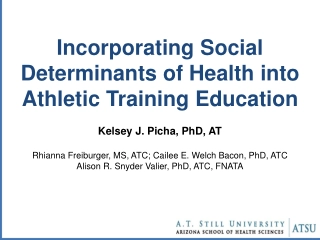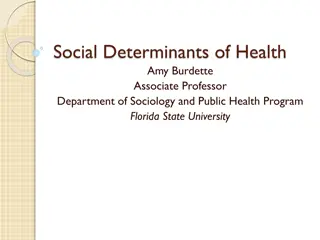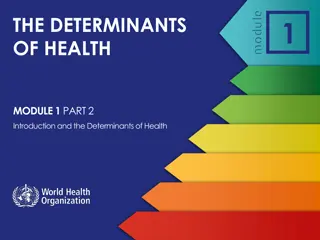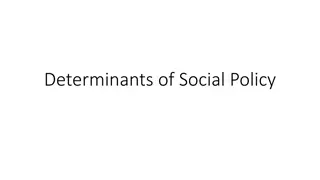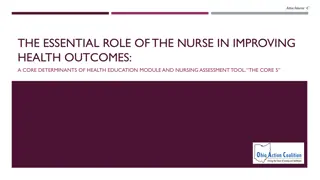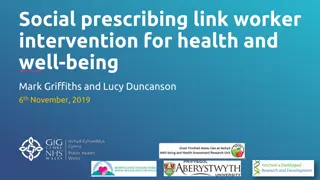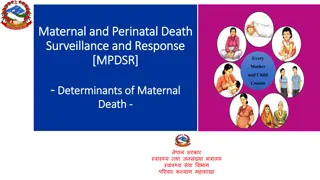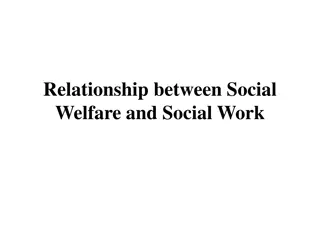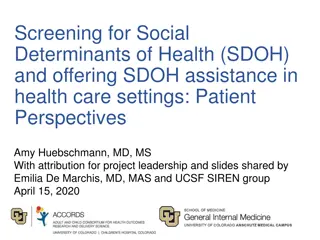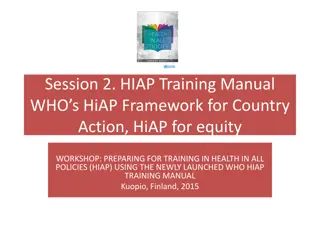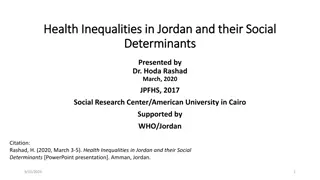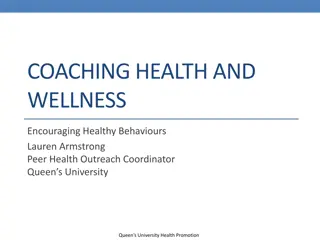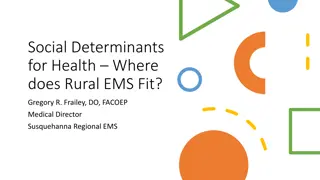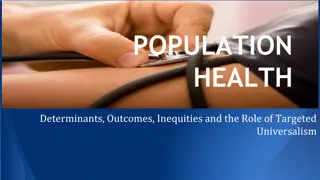Understanding Social Determinants of Health and Their Impact on Well-being
Social determinants of health encompass a wide range of factors, including income, education, employment, and genetics, that significantly influence individual and population health outcomes. Research highlights the importance of addressing these determinants to improve health and reduce disparities. Factors like income and social status, education, and access to health services play a crucial role in shaping health outcomes, with higher social and economic status associated with better health. Recognizing and addressing these social determinants are essential steps in promoting overall well-being and health equity.
Download Presentation

Please find below an Image/Link to download the presentation.
The content on the website is provided AS IS for your information and personal use only. It may not be sold, licensed, or shared on other websites without obtaining consent from the author. Download presentation by click this link. If you encounter any issues during the download, it is possible that the publisher has removed the file from their server.
E N D
Presentation Transcript
Social Determinants of Health Addressing Health Social Inequities
What are the Social Determinants of Health The World Health Organization defines the social determinants of health as the conditions in which people are born, grow, work, live, and age, and the wider set of forces and systems shaping the conditions of daily life (para. 1) https://www.who.int/health-topics/social-determinants-of-health#tab=tab_1 They are an extensive range of personal, social, economic, and environmental factors that influence individuals health and well-being and determine individual and population health. There are various versions but the following determinants are recognized by the Public Health of Canada.
Social Determinants of Health Include: Income and social status Employment and working conditions Education and literacy Childhood experiences Physical environments Social supports and coping skills Healthy behaviours Access to health services Biology and genetic endowment Gender Culture Race/ racism
Why are These Important? Research indicates social determinants of health can be more important that health care or lifestyle choices in influencing health. Numerous studies suggest that social determinants of health account for between 30-55% of health outcomes. Addressing social determinants of health is fundamental for improving health and reducing longstanding inequities in health.
1. Income and Social Status Health status improves at each step of the income and social hierarchy. Income impacts living conditions, safe housing, and ability to buy sufficient food. The healthiest populations are those societies that are thriving and have equitable distribution of wealth. Research indicates that the degree of control people have over life circumstances (especially stressful ones) and their ability to act are key influences of health. Higher income and status usually results in more control and discretion. Recent studies have indicated that limited options and poor coping skills (related to stress), increase vulnerability to a range of diseases, especially those that involve immune and hormonal systems.
1. Evidence for Income and Social Status Higher social and economic status is associated with better health. These 2 factors are the most importance determinants of health. Only 47% of Canadians in the lowest bracket rate their health as very good or excellent, compared to 73% of the highest income group. At each rung up the economic ladder, Canadians experience less sickness, longer life expectancies, and improved health. The distribution of income in a given society may be a more important determinant of health than the total amount of income earned by society members. Large gaps in income distribution lead to increases in social problems and poorer health among population as a whole.
2. Employment and Working Conditions Unemployment, underemployment, stressful, and/or unsafe work conditions are all associated with poorer health. Individuals that are unemployed have a reduced life expectancy and suffer significantly more health problems than people who are employed. Individuals that have more control over their work conditions and fewer stress related demands (in the workplace) are healthier and generally live longer than individuals that work in more stressful or riskier work environments. Employment has a significant affect on an individual s physical, mental, and social health. Paid work provides money, a sense of identity, purpose, social contacts, and opportunities for personal growth.
2. Evidence: Employment/ Working Conditions Conditions at work (both physical and psychosocial) can have an extensive effect on an individual s health and emotional well-being. Outside of paid work, many Canadians spend numerous hours engaged in unpaid work such as a care giver, child care, and household chores. With the combination of these workloads, on an ongoing basis, sometimes with minimal support, an individual s stress level and job satisfaction are negatively affected. High levels of unemployment, combined with economic instability in an area can cause significant mental health problems and have adverse effects on the physical health of an unemployed individual, along with their families and communities.
3. Education and Literacy Health status improves with the level of education. Education is closely tied to socioeconomic status. Effective education for children and lifelong learning for adults are key contributors to health and success for individuals. Education equips people with knowledge and skills for problem solving, and helps to provide a sense of control over life circumstances. Education improves an individual s ability to access and understand information to help keep them healthy, physically and mentally.
3. Evidence and Education and Literacy Canadians with low literacy rates are more apt to be unemployed and poor, to suffer poorer health, and to die earlier than Canadians with high levels of literacy. Individual s with higher levels of education have better access to healthier physical environments and are better able to prepare their children for school than individuals with low levels of education. In 1990, Health Canada found that the number of lost workdays decreases with increasing education.
4. Childhood Experiences Early child development is a powerful determinant of health. A young person s development is greatly affected by his or her housing, neighbourhood, family income, level of parents education, access to nutritious foods and physical recreation, genetic makeup, and access to dental and medical care. These factors can greatly affect the physical, social, mental, emotional, and spiritual development of children and youth.
4. Evidence and Childhood Experiences Experiences from conception to age 6 have a great impact in the lifecycle of the connecting and sculpting of the brain s neurons. Positive stimulation early in life improves learning, behaviour, and health into adulthood. Tobacco and alcohol use during pregnancy can lead to poor birth outcomes. A loving and secure attachment between parents (care givers) and babies in the first 18 months of life helps children to develop trust, self- esteem, emotional control and the ability to have positive relationships with others as adults. Infants and children who were neglected or abused are at higher risk for injuries, and a number of social, behavioural, and cognitive problems later in life.
5. Physical Environments The physical environment is an important determinant of health. At certain levels of exposure, contaminants in our food, water, air, and soil can cause different health effects, including cancer, birth defects, respiratory illness, and gastrointestinal issues. Factors related to housing, indoor air quality, and the design of communities and transportation systems can influence physical and psychological well-being.
5. Evidence and Physical Environments Childhood asthma is highly sensitive to airborne contaminants and has increased sharply over the last two decades. Children and outdoor workers may be especially susceptible to the health effects of a reduced ozone layer. Excessive exposure to UV-B radiation can cause sunburn, skin cancer, depression of the immune system, and an increased chance of developing cataracts. Research indicates that lung cancer risks from second hand tobacco smoke are greater than the risks from the hazardous air pollutants from all the regulated industrial emissions combined.
6. Social Supports and Coping Skills Social support extends to the broader community. Social stability, recognition of diversity, safety, good working relationships, and cohesive communities provide supportive society that reduces potential risks to good health. Social and/ or community responses can add to resources in your toolkit of strategies to cope with changes and improve health.
6. Evidence and Social Supports and Coping Skills In the U.S., high levels of trust and group membership were found to be associated with reduced mortality rates. Women that are assaulted often suffer severe physical and psychological health problems.
7. Healthy Behaviours and Coping Skills Healthy behaviour refers to actions that individuals can take to prevent diseases and promote self-care, cope with challenges, develop self- reliance, solve problems, and make choices that improve health. Lifestyle includes individual choices, influences of social, economic, and environmental factors on the decisions people make about their health. There is a growing recognition that personal life choices are significantly influenced by socioeconomic environments in which people live, learn, work, and play. These influences impact choice in numerous areas (personal life skills, stress, culture, social relationships, belonging, sense of control). Research is showing that there is a link between disadvantaged childhood and vascular conditions along with other adverse health events.
7. Evidence and Healthy Behaviours and Coping Skills In Canada, smoking is estimated to be responsible for 25% of all deaths for adults ages 35 to 84. Rates have increased among adolescents and youth. Multiple risk factors including hazardous combinations (alcohol, drug use and driving, alcohol, drug use and unsafe sex) are high among young people (especially males). Diet in general and increased fat intake are linked to cancer and coronary heart disease. Effective coping skills allow individuals to be self-reliant, solve problems, and make informed choices. Research suggests that individuals with a strong sense of self-efficacy (self-value) and ability to cope are likely to be more successful in adopting and maintaining healthy behaviours and lifestyles.
8. Access to Health Services Health services that are designed to maintain and promote health, to prevent disease, and to restore health, contribute to population health. The health care continuum includes treatment and secondary prevention. Disease and injury prevention activities such as immunization and the use of mammography are demonstrating positive results.
8. Evidence and Access to Health Services There has been a substantial decline in the average length of hospital stays. Therefore, shifting care to community and home now raises concerns about financial, physical, and emotional burdens placed on families. Many low-and moderate-income individuals have limited or no access to health services such as eye care, dentistry, mental health counselling, and prescription medications.
9. Biology and Genetics The basic biology and make- up of the human body are fundamental as a determinant of health. Genetics can make you prone to a wide range of responses that affect health status and make you more susceptible to particular diseases and health problems.
9. Evidence and Biology and Genetics Studies have shown that when optimal conditions for a child s development are provided between conception and age 5, the brain develops in a way that has positive outcomes for a lifetime. Active living and opportunities for lifelong learning are important for maintaining health and cognitive function in old age. Aging Is not necessarily synonymous with poor health.
10. Gender Gender refers to guidelines placed by society on roles, personality traits, attitudes, behaviours, values, relative power, and influence, that society assigns based on sex (male or female). Gendered norms impacts the health system s practices and priorities. Many health issues and concerns are a function of gender-based social status or roles.
10. Evidence and Gender Men are more likely to die prematurely compared to women (largely due to heart disease, fatal unintentional injuries, cancer, suicide). Women may have a tendency to live longer than men, but women are more prone to suffer depression, stress overload (due to work/ life balance), chronic conditions (arthritis, allergies), and injuries and death resulting from family violence. Cancer rates have decreased for men, but remain among women (mainly due to increase in lung cancer mortality).
11. Culture Some groups or individuals face additional health risks due to socio-economic environment (largely determined by dominant cultural values). Dominant cultural values can contribute to the perpetuation of conditions such as marginalization, stigmatization, language and culture, lack of accessibility to culturally appropriate health care and services.
11. Evidence and Culture First Nations communities have a higher rate of some chronic diseases (diabetes, heart problems, cancer, hypertension, arthritis, rheumatism) compared to some other communities in Canada. Inuit have a higher rate of suicide in Canada. A 1996-97 survey found that immigrant and refugee children were doing better emotionally and academically than their Canadian born peers. Poverty among Canadian born population may have a different meaning than for newly arrived immigrants.
12. Race and Racism Racism takes numerous forms; Institutional racism-is concerned with the structures of society and are found in the institutions of law and government inaction in the face of need. Personally mediated racism-is defined as prejudice and discrimination, and can exhibit itself as lack of respect, suspicion, devaluation, scapegoating, and dehumanization. Internalized racism-is when those who are labelled accept these messages about their own abilities and internalize their negative self- worth. This can lead to resignation, helplessness, and lack of hope. Any racism affects an individual s health and well-being including Canadian society as a whole.
Social Determinants of Health and COVID-19 There is increasing evidence that COVID-19 disproportionately affects Black, Latino, and other ethnic minorities and racialized communities in Canada, U.S., and the United Kingdom. Gender, socioeconomic position, race/ ethnicity, occupation, Indigeneity, homelessness, and incarceration, play an important role in risk of COVID-19 infection. Existing social inequities in health increase risk of severe COVID-19 outcomes through increased prevalence of underlying medical conditions and/ or decreased access to care.
Resources The social determinants of health influence the health of populations: https://cbpp-pcpe.phac-aspc.gc.ca/public-health-topics/social- determinants-of-health/ Understanding inequities: https://www.canada.ca/en/public- health/services/publications/science-research-data/understanding- report-key-health-inequalities-canada.html
References https://thecanadianfacts.org/The_Canadian_Facts.pdf https://www.thecanadianfacts.org/The_Canadian_Facts-2nd_ed.pdf https://www.canada.ca/en/public-health/services/health- promotion/population-health/what-determines-health.html https://www.canada.ca/en/public-health/services/health- promotion/population-health/what-determines-health/what-makes- canadians-healthy-unhealthy.html https://www.oha.com/news/research-and-information-on-covid-19- social-determinants-of-health https://www.publichealthontario.ca/-/media/documents/ncov/covid- wwksf/2020/05/what-we-know-social-determinants-health.pdf?la=en


